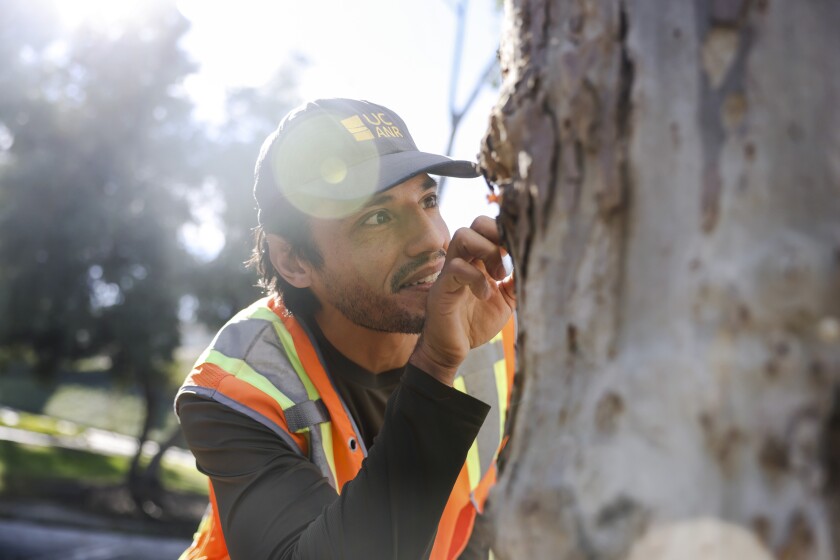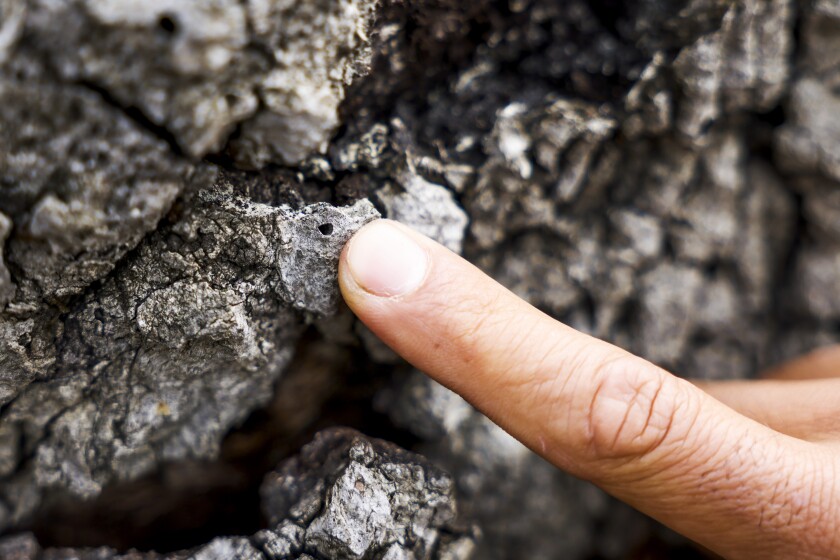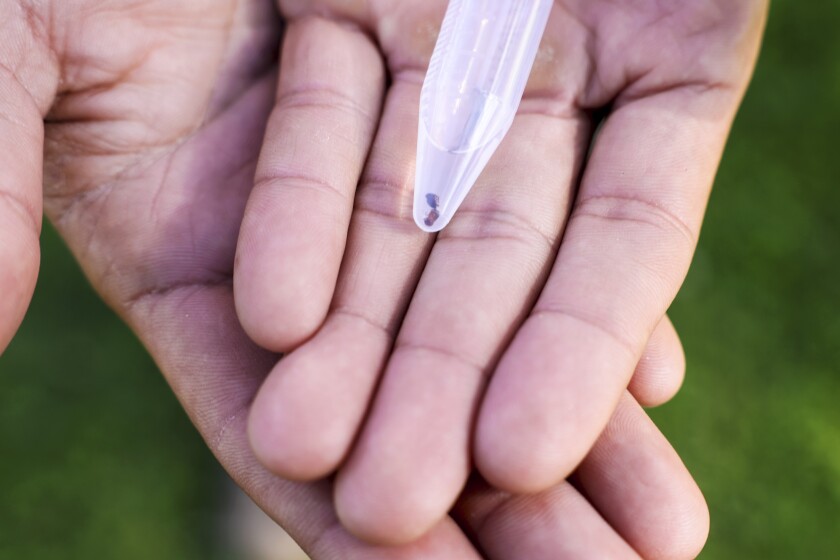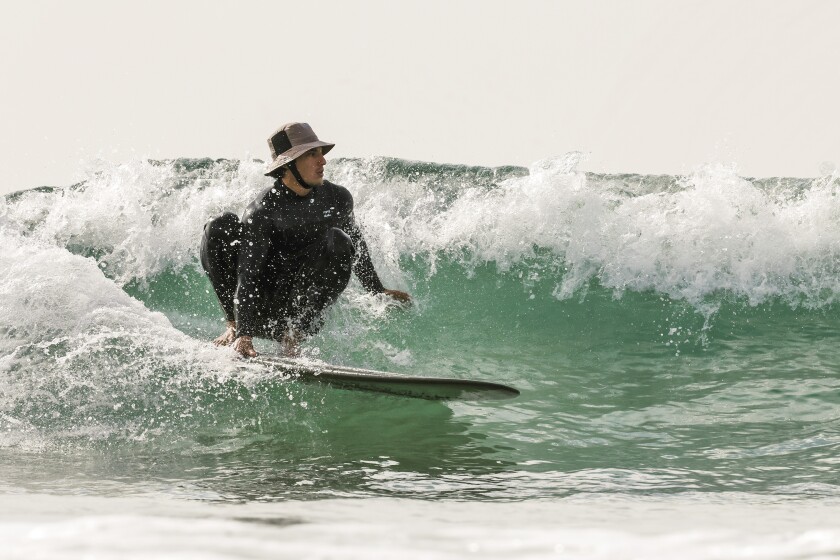Our urban forests are in peril. ‘Garden Bro’ to the rescue!
This is the latest in a series we call Plant PPL, for which we interview people of color in the plant world. If you have any suggestions for PPL to include in our series, tag us on Instagram @latimesplants.
With his tousled black hair and heart-melting smile, Gabe Verduzco certainly has the looks of an influencer, but instead of sharing dance moves or crazy pranks he’s making his mark on social media by posting pictures of insects and native flowers, or himself in an orange workman’s vest climbing a massive oak tree in search of tiny beetles threatening our urban trees.
See, Verduzco is to flora what Superman is to Lois Lane. He’s had a hard crush on plants since he was a young teen — embracing chores like weeding or mowing the lawn, growing pumpkins and tomatoes for his family and, at 15, creating a Tumblr page called #GardenBros — “just a group of friends trying their hands at gardening” near their San Joaquin Valley homes in Kingsburg, south of Fresno.
Some 18 years later he lives in Dana Point so he can surf at least once a day. But plants are still the mainstay of his private and professional lives. He tends a vegetable garden outside his apartment. He manages the Orange County chapter of the California Native Plant Society’s social media as a volunteer. He’s a part-time park ranger trying to stop poachers from stealing succulents and other native plants off coastal hills. His Instagram account, @antsyplantsy, is chockablock with posts about native plants and creatures.
And then there’s his main gig as a research associate for the University of California Cooperative Extension’s Agriculture and Natural Resources division, crawling around big urban trees like oaks and sycamores searching for the invasive shothole borer and the goldspotted oak borer — rice-size beetles that have killed many thousands of Southern California oaks, sycamores, willows and other trees since they were discovered less than 20 years ago and could well destroy many of our urban trees if left unchecked.

Gabe Verduzco peers closely at a sycamore looking for invasive shothole borer beetles in Anaheim Hills.
(Dania Maxwell / Los Angeles Times)
“I’ve seen them kill trees in six months,” Verduzco says. “And they’re tough. We had an infected piece of wood from a pallet put into a cage in our lab and a [shothole] beetle came out three months later, from a dead piece of wood.”
Right now, these beetles don’t have any natural predators in Southern California, so there’s little to stop their spread except spotters like Verduzco. And often, by the time the damage to a tree becomes apparent, little can be done to save it. The best (yet saddest) course of action is to remove the tree so the beetles won’t infect others nearby. Verduzco’s employer, UC Cooperative Extension, focuses on agricultural and horticultural research and education in every county of the state. His job is to search trees in a given area, determine whether they’ve been infested, and if so, how badly. Then he marks and maps those trees so others can either treat or remove them.
Finding infestations is a daunting task — just think of all the trees on your street — but Verduzco makes the work look fun, as in a TikTok video where he’s climbing up and over the sprawling limbs of a giant oak. His videos are playful, but Verduzco is dead serious about the threat. At the Anaheim Hills Golf Course, for instance, the grounds are edged and dotted with lush stands of native oaks, sycamores and willows. This spot is lovely, almost impossible to believe it’s just a few miles from the stark 91 Freeway corridor. But Verduzco and his colleagues have found multiple dead trees here, mostly oak, and many others that are infected, some beyond the chance of saving.
Invasive shothole borers leave rust-colored stains on the outside of a tree and tiny holes roughly the size of a half-grain of rice. The G-SOB beetle is harder to spot. It makes a tiny D-shaped exit hole, but on a craggy section of tree bark it’s almost impossible to find until Verduzco points one out.
It took some practice to learn how to spot the signs, Verduzco said, but now he can’t stop seeing them, like during a recent visit to a Los Angeles museum, when he noticed some telltale holes on a tree outside.
“It wasn’t anything serious, a pretty light infestation they can manage,” he said, talking almost to himself, “but I just reminded myself … I need to let them know.”

Gabe Verduzco points to a small, D-shaped hole where a goldspotted oak borer exited the trunk of a coast live oak.
(Dania Maxwell / Los Angeles Times)
Here’s how Verduzco explains his journey from inquisitive boy in the San Joaquin Valley, carving pumpkins and wondering how they grow, to a gung-ho, plant-centric, surfing adult.
He knew nothing. And then grew the best corn ever.
“I grew up playing sports and being outside. I always had a knack for nature; bugs and other critters were always enticing to me. I just love being outside.
“We always carved pumpkins when I was a kid and baked the seeds, and one day I thought, ‘Why don’t I grow pumpkins?’ I just put the seeds in the soil, not knowing what I was doing, but that’s how I started. I was 12 or 13 and my mom thought they were weeds and pulled them out. She didn’t know. I was the one who liked doing yard work — pulling weeds, mowing the lawn — and nobody ever showed me. That’s one thing I love about gardening — you just learn by doing, by teaching yourself.
“I started growing tomatoes the next year and getting magazines and seed catalogs, and doing more research. My mom moved into a rental in Kingsburg and said I could grow stuff in the space on the side of the house. I cut down all the bushes there so I could plant vegetables and my mom said, ‘Are you going to plant the bushes back when we leave?’ and I said, ‘Yeah,’ … but I don’t think I ever did.

Gabe Verduzco, a research assistant for UC Agriculture and Natural Resources, spends his days searching for two invasive beetles that are killing oaks, sycamores and other trees in SoCal’s urban forests.
(Dania Maxwell / Los Angeles Times)
“I started growing tomatoes and cucumbers, these super exciting Armenian cucumbers, and lemon cucumbers, which are amazing. And then I grew some sweet corn varieties from Johnny’s Seeds. It was the corn they were growing at Fresno State, people went crazy for that corn, and I finally found somebody who gave me the variety name — Vision — and I started growing that corn too — the best corn I’ve ever had.
“Then when I was 15 and a half I started working with the USDA, watering and planting plants for a grape breeder. They were doing different experiments to find organic methods to prolong the life of table grapes besides coating them with pesticides. They let me use the greenhouse to start my seeds and that really helped me get into the plant world.”
‘Garden Bros” became an excuse to just hang out’
“I started ‘Garden Bros’ on Tumblr with some of my friends. We were still in high school, about to start college, and one of my friends was interested in my gardening. His family lived out in the country with an acre of space out there, and they had a large plot we could grow stuff on.
“We started it as way for our friends to hang out. We’d have bonfires and barbecues, get other friends involved. My whole goal was to get the Garden Bros into local farmers markets to sell corn and tomatoes, but that kind of fizzled out after we graduated and went to work. But that always has been a personal goal, starting a farm and growing stuff for folks.

Gabe Verduzco holds a sample of the invasive shothole borer that is killing off trees in Southern California.
(Dania Maxwell / Los Angeles Times)
“The real joy I have in growing vegetables is reaping the rewards of growing your own — knowing where it came from, knowing what you’re growing and how you’re watering it, how you’re feeding it and building the soil, and all those things coming together so eventually you can pick it and eat it. That joy, that taste, is so rewarding.
“But the other thing I love is giving vegetables away. When I was growing up we had so many tomatoes we were giving them to family and friends. Then one day I saw we had a new neighbor across the street, so I thought I would just be friendly. Here I am, 16 or 17, and I’m going over there to say, ‘Hey, I grew these tomatoes and I wanted to give you some,’ and it broke the ice. I told them my name was Gabe and we talked a little, but the really special moment came a couple weeks later when they brought over a watermelon, just for me. It was cool to see we were basically bartering, with vegetables.”
Instagramming secret wilderness zones
“I got my degree in plant science at Fresno State and I went to work for Filoli Gardens, a botanic garden in Woodside, near Palo Alto. I really got into native plants there while I was helping to restore their native garden, and it really took off from there.
“Now [as a research associate for UC Cooperative Extension looking for invasive beetles] I work directly with native trees in county parks and some of the wilderness zones in the county. I see a lot of untouched areas where the public has no access to, and I’ve started documenting all the beautiful flowers I see. I like to research them, find out their scientific names or how the Native Americans used them, and then post them on Instagram [@antsyplantsy].
“Native plants were here for years and years before we came, and they’re well adapted to their particular areas. For here, it’s rainy winters and hot summers, and the native insects and birds rely on eating certain seeds or plants. When you take that away and put in palm trees instead, it breaks the whole ecological web. And I think native plants also offer some beauty in their history with the Native Americans and how they used them. … Like I’m also a park ranger part-time; I help patrol at the Dana Point Nature Reserve, and I found this native wild cucumber that looks like an alien plant. It’s so spiky and awesome, it just spurred me on. It’s in the cucumber family but it’s poisonous, so how did Native Americans use this? They made the root into a powder and used it to stun fish!”
“Now I’m heavy into native plants and helping the California Native Plant Society by volunteering to do the social media for the Orange County chapter. I’m so intrigued by bugs and plants, and learning about them — educating myself — just excites me about life.”

Gabe Verduzco takes a break to surf at the north side of the Newport Beach Pier.
(Dania Maxwell / Los Angeles Times)
He also surfs every day
“I picked it up five years ago, after I spent a year in Hawaii planting a fruit farm. I’d always wanted to surf, so I just moved to Hawaii for a year and went head-on at it, and when I came back in 2017 I kept surfing. I surf every single day — any time I can fit it in, based on the swells and high tide-low tide. I’ll go at sunrise or sunset or the middle of the day during lunch break. I’ll go out for 30 minutes, or on Saturdays, three hours. I’d say I’m now submersed in surf culture — and I’ll be surfing the rest of my life.
“That’s why I moved to Dana Point. My landlord is a former pro surfer who grew up in Dana Point, and he’s super cool, totally into the surf culture here. He knows all about the wind and swell size, all the surf stuff that’s beyond my knowledge because he’s been doing it all his life. I’m learning a lot from him, and he lets me have a vegetable garden where I’m living, just a little raised bed with strawberries and, this summer, cucumbers and tomatoes.
Posting on TikTok shows that ‘anyone can do this’
“I’m [of] Mexican heritage, born in California, and I’m trying to show people that anyone can do this. You don’t have to fit in a certain mold. It’s like, ‘Hey, you don’t have to be Martha Stewart to care about plants and care about the Earth.’
“And I want to show people what I’m doing. I’ve been on a path not lots of people have been on, and I’m trying to be an advocate for other individuals, maybe those coming from a less fortunate background or not knowing what they want to do. I’m trying to say, ‘Hey, if you really enjoy something and you’re passionate about something, just because you grew up in a small farm town like Kingsburg or an inner city area, it’s still possible to succeed. There’s so many avenues you can choose with plants.’”
For all the latest Life Style News Click Here
For the latest news and updates, follow us on Google News.
